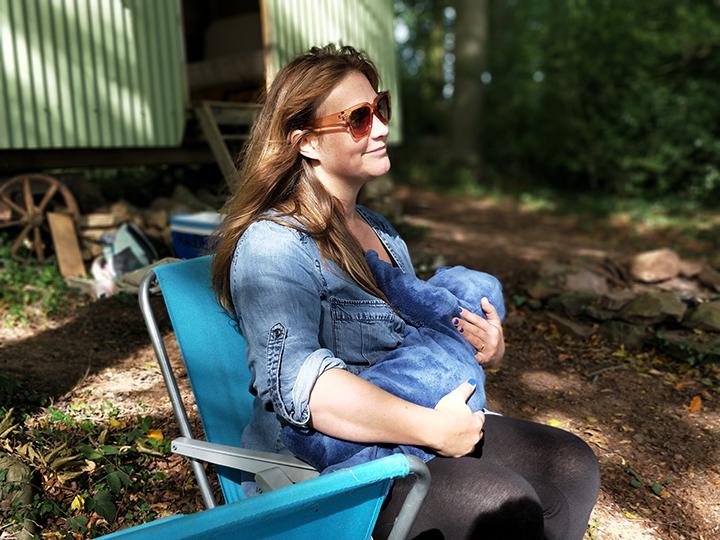| Issue #115 • January/February, 2009 |
Here’s a secret mothers have known since the beginning of time: breastfeeding is the most pro-active, sustainable action a mother can take, and it is so easy. Just think, your body is preparing the nutrients and immunities specific to the needs of that infant sheltered and nurtured by your womb for nine months!
The benefits of breastfeeding are overwhelmingly positive and not just scientifically so: breastfeeding is proven to support cognitive development, and healthy emotional behaviors.
“Although most doctors avoid saying so, out of fear of alienating some clients, formula-fed babies are generally less healthy than breast-fed babies. The cognitive development of babies fed formula doesn’t equal that of those who are breast-fed. Breast milk protects against disease and promotes optimal brain growth. Formula does neither of these things.” (The Nursing Mother’s Companion)
|
During the first year of life, babies fed human milk have lower incidences of respiratory disease, diarrhea and other digestive illnesses, ear infections, urinary tract infections, meningitis, common allergies, and Sudden Infant Death Syndrome (SIDS). Need one more reason? Consider the concept that breastfeeding isn’t just good for you and your baby, it’s good for the environment. As Dr. Miriam Labbok, Director of The Center for Infant and Young Child Feeding and Care in the School of Public Health at the University of North Carolina points out, “Breastfeeding provides low cost, high quality food for children. Supports the environment, reducing use of fuels, pharmaceuticals, plastic and dairy industry waste. Decreases absence in the workplace due to decreased family illness and lowers family expenditures for food and health care.” Breastfeeding is a full-time commitment that can last nine months, one year, two years, and ideally as long as both mother and child desire the relationship to continue. The World Health Organization (WHO) has amended their recommendations and they now advise nursing for a minimum of two years.
There are simple steps all new mothers can follow to begin what one can hope will be a long-term breastfeeding relationship.
Steps for successful breastfeeding initiation
1. Minimize medications during labor and delivery. “In one study, babies whose mothers had received an epidural were less alert, less able to orient themselves, and had less organized movements than babies whose mothers had given birth without medication.” (Womanly Art of Breastfeeding). Medications can hinder babies’ natural ability to suck.
2. Nurse immediately after birth. Breastfeeding releases oxytocina hormone that causes the uterus to contractwhich in turn encourages bleeding to stop and the uterus to go back to its normal size. Infants are most alert immediately following birth. Consider this a window of opportunity to introduce the breast.
3. Skin-to-skin. Calm baby by skin-to-skin contact. For sleepy babies, skin-to-skin contact encourages stimulation so that they can latch on to the breast and nurse.
4. Room-in. If you give birth in a hospital, keep the baby in your room. There is no foreseeable reason why mother and baby should be separated, as long as they are stable. Keep in mind, mother and baby need to begin synchronizing their breastfeeding relationship within the first 24 to 48 hours.
5. Understand the concept of “good” latch. First, find a comfortable position, and when baby is ready, “hold baby’s body under your breasts and firmly against you (shoulders and chest pressed into your body and breast), align baby’s nose to nipple, allow baby’s head to tilt back slightly, support baby firmly behind the shoulders and back, pull her hips against you, and avoid pushing on baby’s head.” (Breastfeeding Made Simple).
6. No artificial nipples! Any time the infant begins sucking on a finger or a fist, they need to be put to the breast. Don’t use pacifiers with an infant whose main sucking energies need to be spent gaining invaluable nutrition at the breast. Remember, milk works on a supply-and-demand basis. The more your baby feeds, the more milk you will produce.
7. Feed on demand. One cue to look for that tells you baby needs to nurse is rootingbaby turns head from side to side with an open mouth, putting hand or fist to mouth, and fussing. Typically an infant will feed from 8 to 12 times within a 24 hour period, and some of those feedings could be two hours apart or back to back. Don’t worry about a schedule, follow your baby’s lead. To assure baby is receiving enough milk, you can count the diaperstypically a baby should have six to eight wet cloth diapers in a 24 hour period (five or six disposables), and two to five bowel movements in a 24 hour period.
8. Get plenty of rest. Lie down when baby is sleeping, even if you are only dozing. Make your bed a comfortable environment for you and baby. Set up water, healthy snacks, and essential diapering needs on a surface close at hand so that you do not have to spend unnecessary energy on meeting your basic needs.
9. Find a support group in your area. La Leche League International (LLLI) is a wonderful community of mothers supporting mothers. Breastfeeding is a learned behavior. New mothers learn a lot by observing how other mothers deal with common concerns. To find an area meeting visit La Leche League International’s web site, www.llli.org.
10. Follow your instincts, and more importantly, follow your baby’s rhythm.
Keep in mind successful breastfeeding hinges on a positive attitude, so consider before your baby is born where you are on the “commitment” continuum. If you feel doubtful, you might find yourself easily discouraged, while if you strongly believe breast milk is the only option for your baby, then you will be more likely to weather any problems you encounter. In the event of difficulties arising, a Certified Lactation Consultant is an excellent resource to have on hand. (www.ilca.org/falc.html) Not only will a Lactation Consultant work with you on a one-on-one basis, but many are on call 24/7 and can come to your home to observe the environment. Breastfeeding does not have to be hard, isolating, or painful. If it is painful then call your local LLLI Leader or a Lactation Consultant.
Once you’ve established milk supply and a healthy relationship, enjoy your baby who will grow way too quickly.
To encourage long-term breastfeeding, do not push solids or liquids before the baby has exhibited signs of readiness. It is important to maintain your milk supply, and starting solids too early can substitute an inferior food for mother’s superior food. Some babies are ready at six months, others nine months, and some not until after the first year. Signs that baby is ready for solids include sitting up on his or her own, the ability to grasp small objects with his or her fingers, no tongue thrusting, and a desire to participate at the family table. Remember, until the baby is one year of age, offer breast milk before solids or other liquids.
The long-term breastfeeding relationship is highly rewarding. Not only are you continuing to provide immunities and nutrition to your child, but the relationship blossoms into a form of comfort and joy. It’s an incredible experience to hear your toddler ask to nurse, or to interrupt mid-feeding to tell you something about their day. Success begins within the first hours of life. Breathe deeply and nurse that baby.
|
















Perfection! Thank you for sharing the endless benefits of breastfeeding. Many forget that this is what our breasts are made for – and they do it quite well!